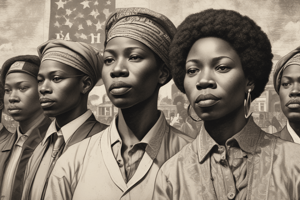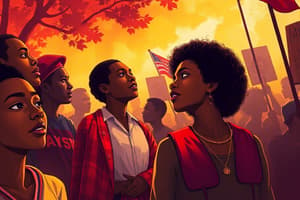Podcast
Questions and Answers
What legal amendments aimed at providing equality for African Americans were established during the Reconstruction era?
What legal amendments aimed at providing equality for African Americans were established during the Reconstruction era?
- 14th and 15th Amendments only
- 13th, 14th, and 15th Amendments (correct)
- 12th and 16th Amendments
- 13th and 19th Amendments
Which of the following made it difficult for African Americans to vote after Reconstruction?
Which of the following made it difficult for African Americans to vote after Reconstruction?
- Civil Rights Act
- Voting Rights Act
- Jim Crow Laws (correct)
- Emancipation Proclamation
What was one of the primary contributions of the NAACP in the fight for civil rights?
What was one of the primary contributions of the NAACP in the fight for civil rights?
- Using litigation to challenge segregation laws (correct)
- Establishing public schools for black children
- Organizing economic boycotts against white businesses
- Promoting military service for African Americans
Which event was sparked by Rosa Parks' refusal to give up her seat?
Which event was sparked by Rosa Parks' refusal to give up her seat?
How did President Truman contribute to civil rights during his presidency?
How did President Truman contribute to civil rights during his presidency?
What was the significance of the Little Rock Crisis in 1957?
What was the significance of the Little Rock Crisis in 1957?
Which prominent figure is known for advocating non-violent resistance during the Civil Rights Movement?
Which prominent figure is known for advocating non-violent resistance during the Civil Rights Movement?
What cultural movement contributed to increased black consciousness in the early 20th century?
What cultural movement contributed to increased black consciousness in the early 20th century?
Flashcards are hidden until you start studying
Study Notes
Historical Context
- African Americans faced oppression for centuries, including slavery and segregation.
- The Civil War and Reconstruction brought theoretical equality through the 13th, 14th, and 15th Amendments.
- These rights were not effectively enforced, leading to the rise of Jim Crow laws, which disenfranchised black voters and upheld segregation.
Long-Term Causes of the Civil Rights Movement
- Organizations like NAACP used litigation to fight segregation.
- Key figures like W.E.B. Du Bois and Booker T. Washington had contrasting views on achieving equality.
- The Harlem Renaissance and the Great Migration increased Black consciousness and activism.
Short-Term Causes of Mass Activism (1945-55)
- African American contributions in World War II fueled their desire for civil rights.
- President Truman's support for civil rights, including desegregating the armed forces, set a precedent for future activism.
Key Events and Figures
- The Montgomery Bus Boycott (1955), sparked by Rosa Parks' arrest, showcased the effectiveness of nonviolent protests and community organization.
- The Little Rock Crisis (1957) involved federal intervention by President Eisenhower to protect nine black students facing violent opposition at Central High School, Arkansas.
The Role of Martin Luther King Jr.
- King emerged as a leading advocate for nonviolent resistance.
- His involvement in the Montgomery Bus Boycott and impactful speeches, including the "I Have a Dream" speech, galvanized support for civil rights.
- King faced challenges in Northern cities like Chicago, which demonstrated the complex economic struggles and de facto segregation African Americans experienced.
Emergence of Black Power
- Black Power emphasized racial pride, economic self-sufficiency, and sometimes a more militant approach to achieving civil rights.
- This contrasted with King's non-violent philosophy.
Significance of the Civil Rights Movement
- The Civil Rights Act of 1964 and the Voting Rights Act of 1965 were major achievements, dismantling legal segregation and protecting African American voting rights.
Studying That Suits You
Use AI to generate personalized quizzes and flashcards to suit your learning preferences.




